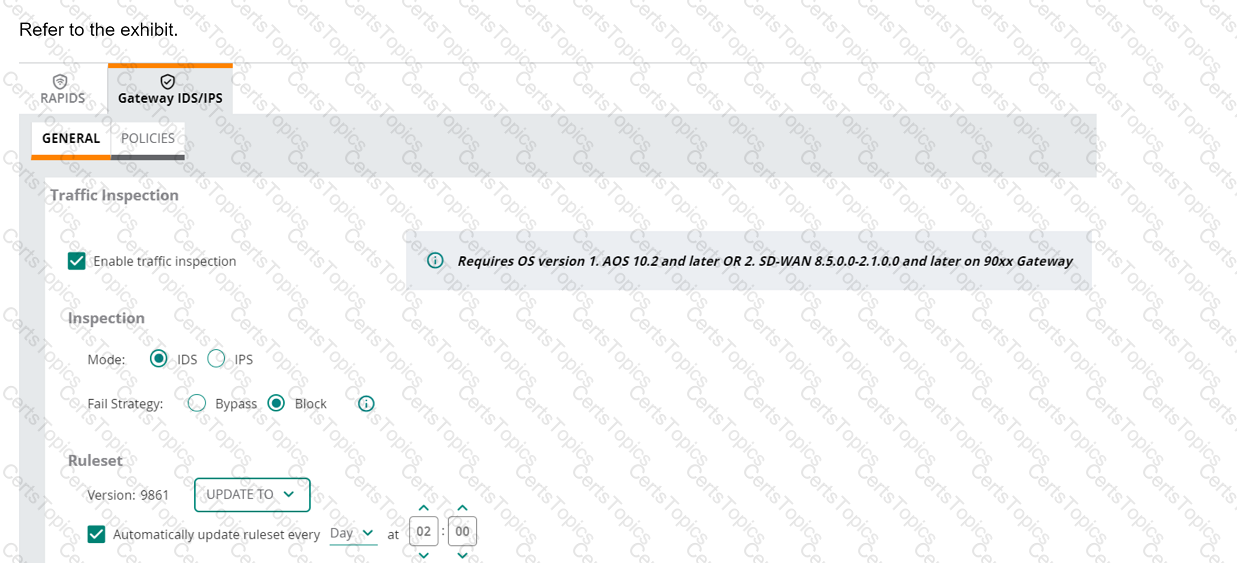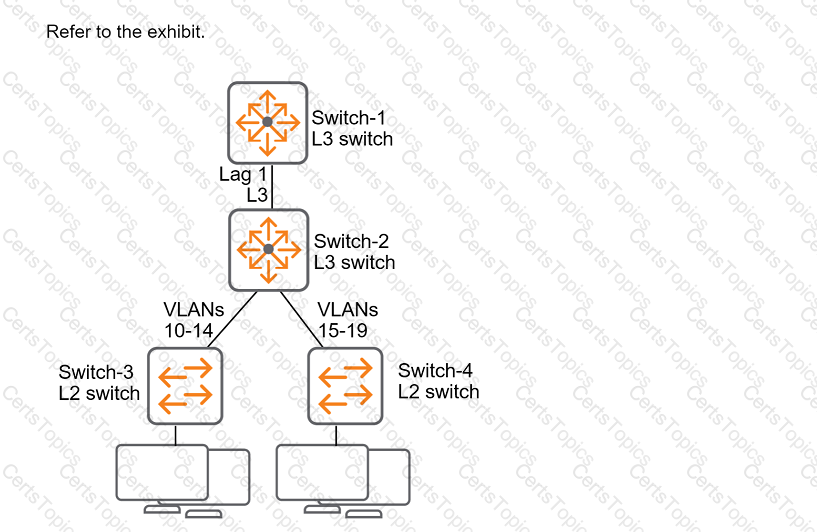What is a typical use case for using HPE Aruba Networking ClearPass Onboard to provision devices?
You have created a Web-based Health Check Service that references a posture policy. You want the service to trigger a RADIUS change of authorization (CoA) when a client receives a Healthy or Quarantine posture. Where do you configure those rules?
You need to use "Tips:Posture" conditions within an 802.1X service's enforcement policy.
Which guideline should you follow?
HPE Aruba Networking Central displays a Gateway Threat Count alert in the alert list. How can you gather more information about what caused the alert to trigger?
You need to set up an HPE Aruba Networking VIA solution for a customer who needs to support 2100 remote employees. The customer wants employees to
download their VIA connection profile from the VPNC. Only employees who authenticate with their domain credentials to HPE Aruba Networking ClearPass Policy
Manager (CPPM) should be able to download the profile. (A RADIUS server group for CPPM is already set up on the VPNC.)
How do you configure the VPNC to enforce that requirement?
HPE Aruba Networking Central displays an alert about an Infrastructure Attack that was detected. You go to the Security > RAPIDS events and see that the attack
was "Detect adhoc using Valid SSID."
What is one possible next step?
A company wants to apply role-based access control lists (ACLs) on AOS-CX switches, which are implementing authentication to HPE Aruba Networking ClearPass Policy Manager (CPPM). The company wants to centralize configuration as much as possible. Which correctly describes your options?
You are using OpenSSL to obtain a certificate signed by a Certification Authority (CA). You have entered this command:
openssl req -new -out file1.pem -newkey rsa:3072 -keyout file2.pem
Enter PEM pass phrase: **********
Verifying - Enter PEM pass phrase: **********
Country Name (2 letter code) [AU]:US
State or Province Name (full name) [Some-State]:California
Locality Name (eg, city) []:Sunnyvale
Organization Name (eg, company) [Internet Widgits Pty Ltd]:example.com
Organizational Unit Name (eg, section) []:Infrastructure
Common Name (e.g. server FQDN or YOUR name) []:radius.example.com
What is one guideline for continuing to obtain a certificate?
A company has wired VolP phones, which transmit tagged traffic and connect to AOS-CX switches. The company wants to tunnel the phones' traffic to an HPE
Aruba Networking gateway for applying security policies.
What is part of the correct configuration on the AOS-CX switches?
What role can Internet Key Exchange (IKE)/IKEv2 play in an HPE Aruba Networking client-to-site VPN?

The exhibit shows the 802.1X-related settings for Windows domain clients. What should admins change to make the settings follow best security practices?
A company has a variety of HPE Aruba Networking solutions, including an HPE Aruba Networking infrastructure and HPE Aruba Networking ClearPass Policy Manager (CPPM). The company passes traffic from the corporate LAN destined to the data center through a third-party SRX firewall. The company would like to further protect itself from internal threats. What is one solution that you can recommend?
You manage AOS-10 APs with HPE Aruba Networking Central. A role is configured on these APs with the following rules:
Allow UDP on port 67 to any destination
Allow any to network 10.1.6.0/23
Deny any to network 10.1.0.0/16 + log
Deny any to network 10.0.0.0/8
Allow any to any destination
You add this new rule immediately before rule 2:
Deny SSH to network 10.1.4.0/23 + denylist
What happens when a client assigned to this role sends SSH traffic to 10.1.11.42?
What is one use case that companies can fulfill using HPE Aruba Networking ClearPass Policy Manager's (CPPM's) Device Profiler?
HPE Aruba Networking Central displays an alert about an Infrastructure Attack that was detected. You go to the Security > RAPIDS events and see that the attack was "Detect adhoc using Valid SSID." What is one possible next step?
A company is using HPE Aruba Networking Central SD-WAN Orchestrator to establish a hub-spoke VPN between branch gateways (BGWs) at 1164 site and VPNCs at multiple data centers. What is part of the configuration that admins need to complete?
A port-access role for AOS-CX switches has this policy applied to it:
plaintext
Copy code
port-access policy mypolicy
10 class ip zoneC action drop
20 class ip zoneA action drop
100 class ip zoneB
The classes have this configuration:
plaintext
Copy code
class ip zoneC
10 match tcp 10.2.0.0/16 eq https
class ip zoneA
10 match ip any 10.1.0.0/16
class ip zoneB
10 match ip any 10.0.0.0/8
The company wants to permit clients in this role to access 10.2.12.0/24 with HTTPS. What should you do?
A company wants to apply a standard configuration to all AOS-CX switch ports and have the ports dynamically adjust their configuration based on the identity of
the user or device that connects. They want to centralize configuration of the identity-based settings as much as possible.
What should you recommend?
A company has HPE Aruba Networking APs running AOS-10 and managed by HPE Aruba Networking Central. The company also has AOS-CX switches. The security team wants you to capture traffic from a particular wireless client. You should capture this client’s traffic over a 15-minute time period and then send the traffic to them in a PCAP file. What should you do?
The following firewall role is configured on HPE Aruba Networking Central-managed APs:
wlan access-rule employees
index 3
rule any any match 17 67 67 permit
rule any any match any 53 53 permit
rule 10 5 5.0 255.255 255.0 match any any any deny
rule 10.5 0.0 255.255 0.0 match 6 80 80 permit
rule 10.5 0.0 255.255.0.0 match 6 443 443 permit
rule 10.5.0.0 255.255.0.0 match any any any deny
rule any any match any any any permit
A client has authenticated and been assigned to the employees role. The client has IP address 10.2.2.2. Which correctly describes behavior in this policy?

(Note that the HPE Aruba Networking Central interface shown here might look slightly different from what you see in your HPE Aruba Networking Central
interface as versions change; however, similar concepts continue to apply.)
An HPE Aruba Networking 9x00 gateway is part of an HPE Aruba Networking Central group that has the settings shown in the exhibit. What would cause the
gateway to drop traffic as part of its IDPS settings?
An AOS-CX switch has been configured to implement UBT to a cluster of three HPE Aruba Networking gateways.
How does the switch determine to which gateways to tunnel UBT users' traffic?
You are setting up an HPE Aruba Networking VIA solution for a company. You have already created a VPN pool with IP addresses for the remote clients. During
tests, however, the clients do not receive IP addresses from that pool.
What is one setting to check?
You want to examine the applications that a device is using and look for any changes in application usage over several different ranges. In which HPE Aruba Networking solution can you view this information in an easy-to-view format?
You are establishing a cluster of HPE Aruba Networking ClearPass servers. (Assume that they are running version 6.9.).
For which type of certificate is it recommended to install a CA-signed certificate on the Subscriber before it joins the cluster?
A company wants to turn on Wireless IDS/IPS infrastructure and client detection at the high level on HPE Aruba Networking APs. The company does not want to
enable any prevention settings.
What should you explain about HPE Aruba Networking recommendations?

All of the switches in the exhibit are AOS-CX switches.
What is the preferred configuration on Switch-2 for preventing rogue OSPF routers in this network?
A company has several use cases for using its AOS-CX switches' HPE Aruba Networking Network Analytics Engine (NAE).
What is one guideline to keep in mind as you plan?
An AOS-CX switch has been configured to implement UBT to two HPE Aruba Networking gateways that implement VRRP on the users' VLAN. What correctly describes how the switch tunnels UBT users' traffic to those gateways?
A company has AOS-CX switches and HPE Aruba Networking APs, which run AOS-10 and bridge their SSIDs. Company security policies require 802.1X on all edge ports, some of which connect to APs. How should you configure the auth-mode on AOS-CX switches?
A company has AOS-CX switches and HPE Aruba Networking ClearPass Policy Manager (CPPM). The company wants switches to implement 802.1X
authentication to CPPM and download user roles.
What is one task that you must complete on the switches to support this use case?
A company wants HPE Aruba Networking ClearPass Policy Manager (CPPM) to respond to Syslog messages from its Check Point firewall. You have added the
firewall as an event source and set up an event service. However, test Syslog messages are not triggering the expected actions.
What is one CPPM setting that you should check?
Your company wants to implement Tunneled EAP (TEAP).
How can you set up HPE Aruba Networking ClearPass Policy Manager (CPPM) to enforce certificated-based authentication for clients using TEAP?
A company has HPE Aruba Networking APs running AOS-10 that connect to AOS-CX switches. The APs will:
Authenticate as 802.1X supplicants to HPE Aruba Networking ClearPass Policy Manager (CPPM)
Be assigned to the "APs" role on the switches
Have their traffic forwarded locally
What information do you need to help you determine the VLAN settings for the "APs" role?
You are establishing a cluster of HPE Aruba Networking ClearPass servers. (Assume that they are running version 6.9.).
For which type of certificate it is recommended to install a CA-signed certificate on the Subscriber before it joins the cluster?
You have created this rule in an HPE Aruba Networking ClearPass Policy Manager (CPPM) service's enforcement policy: IF Authorization [Endpoints Repository]
Conflict EQUALS true THEN apply "quarantine_profile"
What information can help you determine whether you need to configure cluster-wide profiler parameters to ignore some conflicts?
A company needs to enforce 802.1X authentication for its Windows domain computers to HPE Aruba Networking ClearPass Policy Manager (CPPM). The
company needs the computers to authenticate as both machines and users in the same session.
Which authentication method should you set up on CPPM?
You have configured an AOS-CX switch to implement 802.1X on edge ports. Assume ports operate in the default auth-mode. VoIP phones are assigned to the "voice" role and need to send traffic that is tagged for VLAN 12. Where should you configure VLAN 12?
You need to create a rule in an HPE Aruba Networking ClearPass Policy Manager (CPPM) role mapping policy that references a ClearPass Device Insight Tag. Which Type (namespace) should you specify for the rule?